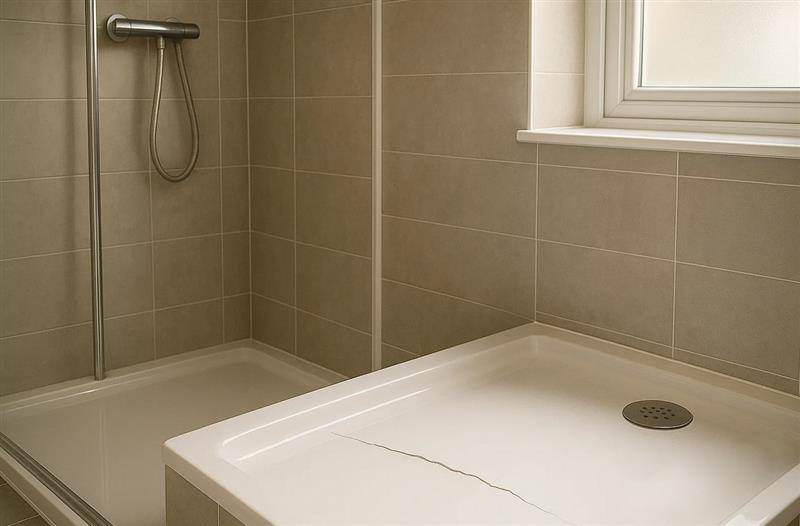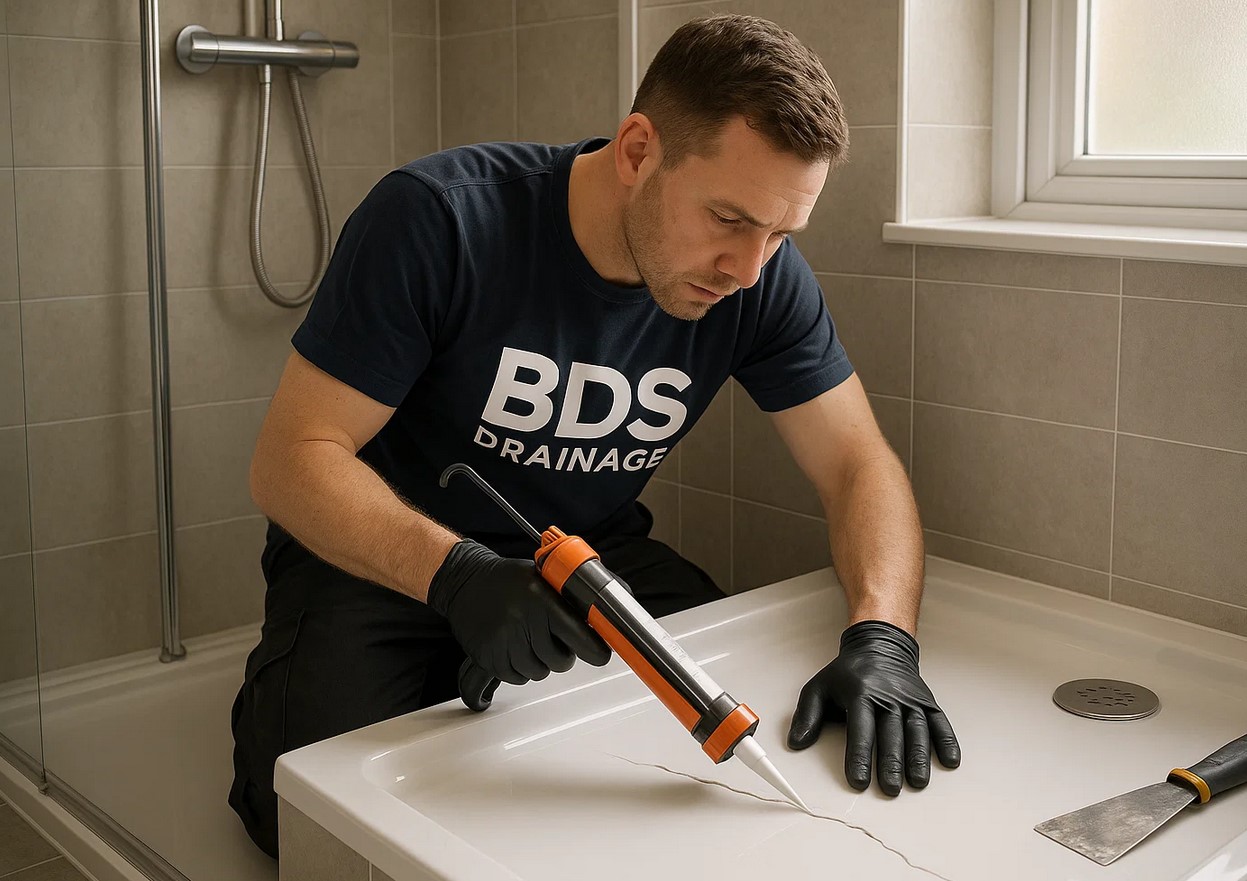Spotting a crack in your shower tray during your morning rinse is one of those special moments, isn’t it? Right up there with finding out your boiler has given up the ghost mid-winter. But before you start frantically googling “emergency plumber near me” and contemplating a second mortgage, take a deep breath. Most shower tray cracks are surprisingly manageable, and with a bit of DIY know-how, you can perform a shower tray crack repair without breaking the bank.
Here at BDS Drainage, we’ve seen it all—from tiny hairline cracks that whisper of future problems to gaping chasms that turn your bathroom into an impromptu paddling pool. The good news? With the right tools and a little patience, you can often fix the problem yourself.
This guide will walk you through everything you need to know to fix a crack in a shower tray, from assessing the damage to achieving a finish so smooth you’ll forget the crack was ever there. We’ll also share a few insider tips from our years in the drainage business because, let’s be honest, the devil is in the details.
Identifying the type of crack

Before you roll up your sleeves and get stuck in, you need to understand what you’re dealing with. Not all cracks are created equal, and a misdiagnosis could lead to more trouble down the line. Give your shower tray a good scrub to get a clear view of the damage.
Hairline cracks
These are the thin, spidery lines that often appear on the surface. They’re usually cosmetic, caused by minor impacts or the tray expanding and contracting with temperature changes. Hairline cracks are the perfect candidates for a DIY fix and respond well to a standard repair kit.
Chips
Small but mighty annoying, chips are usually caused by something being dropped in the shower. Like hairline cracks, these can be patched up fairly easily with the right materials, restoring your shower tray’s smooth surface.
Larger cracks or multiple cracks
If you’re looking at a crack that’s more of a chasm, or several cracks have appeared at once, this could signal a structural issue. Does the shower tray feel a bit like a trampoline when you step on it? If so, it’s likely not supported properly underneath. This is a more serious problem that a simple filling job won’t fix.
DIY cracked shower tray repair: a step-by-step guide

Ready to tackle that crack? Here’s your step-by-step guide to repairing a cracked shower tray with professional-looking results.
Step 1: Gather your materials
A successful repair begins with having all your tools at hand. There’s nothing worse than being halfway through a job and realising you’re missing a crucial piece of kit. You’ll need:
- A shower tray repair kit: You can find these at most DIY stores. An epoxy resin-based kit is usually a safe bet.
- Sandpaper: Fine-grit sandpaper (around 120-240 grit) will do the trick.
- Cleaning supplies: A good cleaner, a sponge, and some clean, dry cloths.
- Safety gear: Protective gloves and eye protection are non-negotiable.
Step 2: Prepare the surface
This is the part many people rush, but proper preparation is the key to a lasting repair. Start by giving the cracked area and its surroundings a thorough clean to remove any soap scum, grease, or dirt. Once it’s clean, make sure the area is completely dry.
Next, lightly sand the surface around the crack. You’re not trying to grind it down, just roughing it up a bit. This creates a better surface for the repair compound to grip onto, ensuring a strong bond. Wipe away any dust with a clean cloth.
Step 3: Mix and apply the epoxy
Now for the time-sensitive part. Most epoxy repair kits have a limited working time once the components are mixed, so read the instructions carefully before you begin.
Mix only as much of the epoxy as you think you’ll need. It’s better to mix a second small batch later than waste a large one. Using a putty knife, apply the mixture to the crack, working it in to ensure it’s completely filled. You’ll want to build it up so it sits slightly proud of the shower tray’s surface. Don’t stress about making it perfectly smooth just yet; that comes later.
Step 4: Cure and finish
Patience is a virtue, especially when it comes to letting the repair cure. While most compounds need a few hours, leaving it to cure overnight will give you the best and strongest result.
Once it’s fully hardened, it’s time to get that smooth finish. Using your sandpaper, start sanding the repaired area. Begin with a coarser grit to level the epoxy with the rest of the tray, then switch to a finer grit to smooth it out until it blends seamlessly. A final polish will have it looking good as new.
When to call a professional to repair cracked shower tray

While a bit of DIY can be satisfying, some jobs are best left to the experts. You should consider calling a professional if:
- The crack is near the waste outlet: This is a high-stress area, and a failed repair could lead to significant leaks.
- There are multiple, interconnected cracks: This is a strong indicator of an underlying structural problem.
- The shower tray feels unstable or spongy: Simply filling the cracks won’t solve the problem if the tray isn’t properly supported.
- You can see signs of water damage: If you notice damp patches on the ceiling below or on the surrounding floor, it’s time to get professional help.
Ignoring these signs can turn a small repair job into a major, expensive renovation. At BDS Drainage, our team can assess the situation, tackle any drain maintenance, and provide a lasting solution.
Frequently asked questions
How long does a DIY shower tray repair last?
If done correctly with quality materials, a DIY repair can last for several years. The key is addressing the root cause of the crack, not just the symptom.
What are the common causes of a cracked shower tray?
Cracked shower trays can result from a variety of issues. One of the most common causes is improper installation, where the tray is not supported evenly, leading to stress and eventual cracking over time. Another common cause is the use of low-quality materials that are prone to wear and tear.
Heavy impacts, such as dropping a heavy object on the tray, can also cause immediate damage. Additionally, prolonged exposure to extreme temperatures or fluctuating humidity levels can weaken the material, making it more susceptible to cracks. Regular maintenance and ensuring proper installation can help prevent these issues.
Can I repair all types of shower trays?
Most acrylic and resin shower trays are repairable with standard kits. However, stone resin or ceramic trays might require specialised products or professional attention. Always check that your repair kit is suitable for your tray’s material.
Is it safe to use the shower right after the repair?
Definitely not. You should wait at least 24 hours for the repair to fully cure. Using the shower too soon can weaken the bond and cause the repair to fail.
What if the crack comes back?
A recurring crack is a classic sign that the underlying issue wasn’t resolved. This usually means the tray needs better support or, in some cases, may need to be replaced.
Can I use the same techniques and methods for repairing a crack in my bathroom sink?
While repairing a cracked tray might seem similar to fixing a bathroom sink, don’t confuse the two. Sinks are often made of porcelain, ceramic, or cast iron, requiring a different repair process and specific repair material kits like porcelain compounds for small cracks. For any repair, always clean and thoroughly dry the damaged area to ensure proper adhesion. Follow the manufacturer’s instructions carefully. If the damage is extensive, or you’re uncertain about the process, it’s wise to consult a professional.
Don’t let a small crack become a big problem
Repairing a cracked shower tray doesn’t have to be a daunting task. By acting quickly and following a careful process, you can achieve a professional-quality fix that will save you from costly water damage and replacement fees down the line.
However, know when to call in the cavalry. If you’re faced with extensive damage or you suspect a structural issue, seeking professional advice is the smartest move. The team at BDS Drainage has handled countless drainage challenges, from simple fixes for blocked drains to complex installations.
If your DIY project feels a bit out of your depth, or if you want an expert opinion on your drainage issues, don’t hesitate to get in touch. Contact BDS Drainage today for a free quote and expert advice to keep your bathroom in top shape.

